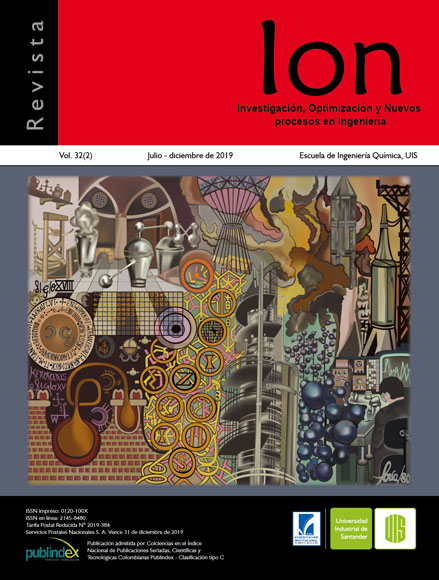Published 2020-03-12
Keywords
- UNIFAC-DMD,
- Thermochemical,
- Equilibrium,
- Simulation,
- Biodiesel.
How to Cite
Abstract
The importance of improving industrial transformation processes to more efficient processes ones is part of the challenges of these times. Specifically, the development of more efficient processes in the production of biofuels where the reaction and separation processes can be intensified are of great interest to reduce the energy consumption associated with the process. In the case of Biodiesel, the process is defined by a chemical reaction and the components associated with the process, the thermochemical study seeks to develop calculations for the subsequent understanding of the reaction and purification project. Thus, the analysis of the mixed components using the Aspen Plus V9® process simulator describes the thermochemical study. For this, the UNIFAC-DMD thermodynamic method was used to estimate the binary parameters of the equilibrium of the raw materials and reactants calculated with the simulator. The observation of the analyzed aspects shows the behavior of the components at different temperature conditions, the azeotropic behavior and thermochemical conditions were determined.
Downloads
References
[2] Meng K, Wu Y, Lin Q, Shan F, Fu W, Zhou K, et al. Microexplosion and ignition of biodiesel/ethanol blends droplets in oxygenated hot co-flow. Journal of the Energy Institute. 2019;92(5):1527-36.
[3] Chen J, Li J, Dong W, Zhang X, Tyagi RD, Drogui P, Surampalli RY. The potential of microalgae in biodiesel production. Renewable and Sustainable Energy Reviews. 2018;90:336-46.
[4] Zhang Y, Huang R, Huang Y, Huang S, Zhou P, Chen X, Qin T. Experimental study on combustion characteristics of an n-butanol-biodiesel droplet. Energy. 2018;160:490-9.
[5] Ambat I, Srivastava V, Sillanpää M. Recent advancement in biodiesel production methodologies using various feedstock: A review. Renewable and Sustainable Energy Review S. 2018;90:356-69.
[6] Baldea M, Edgar TF. Dynamic process intensification. Current opinion in chemical engineering. 2018;22:48-53.
[7] Selaimia R, Beghiel A, Oumeddour R. The synthesis of biodiesel from vegetable oil. Procedia-Social and Behavioral Sciences. 2015;195:1633-8.
[8] Deng Y, Hu X, Cheng L, Wang H, Duan L, Qiu R. Zirconocene-catalysed biodiesel synthesis from vegetable oil with high free fatty acid contents. Journal of Organometallic Chemistry. 2018;870:116-20.
[9] Humphrey JL, Seibert AF, Koort RA. Separation technologies: Advances and priorities. United States of America: Humphrey (JL) and Associates; 1991.[10] Wright RO. Fractionation apparatus. US Patent 2.471.134.1949 May 24.
[11] Romagnoli ÉS, Borsato D, Silva LRC, Chendynski LT, Angilelli KG, Canesin EA. Kinetic parameters of the oxidation reaction of commercial biodiesel with natural antioxidant additives. Industrial Crops and Products. 2018; 125:59-64.
[12] Xuan J, Leung MKH, Leung YCD, Meng L. A review of biomass-derived fuel processors for fuel cell systems. Renewable and Sustainable Energy Reviews. 2008;13(7-8):1-13.
[13] Demirbas A. Progress and recent trends in biodiesel fuels. Energy Conversion and Management. 2009;50(1):14-34.
[14] Gmehling J, Jiding L, Schriller M. A modified UNIFAC model. 2. Present parameter matrix and results for different thermodynamic properties. I&EC research. 1993;32(1):178-93.
[15] Gmehling J, Li J, Schiller M. A modified UNIFAC model. 2. Present parameter matrix and results for different thermodynamic properties. I&EC research. 1993;32(1):178-93.
[16] Wittig R, Lohmann J, Gmehling J. Prediction of phase equilibria and excess properties for systems with sulfones. AIChE Journal. 2003;49(2):530-37.
[17] Jakob A, Grensemann H, Lohmann J, Gmehling J. Further Development of Modified UNIFAC (Dortmund): Revision and Extension 5. I&EC research. 2006;45(23):7924-33.
[18] Narvaez PC, Rincon SM, Sanchez FJ. Kinetics of Palm Oil Methanolysis. Journal of American Oil Chemical Society. 2007;84:971-77.
[19] Fredenslud Aa, Gmehling J, Rasmussen P. Vapor-liquid Equilibria Using UNIFAC. A Group Contribution Model.The Netherlands: Elsevier science publishers B.V;1977.
[20] Pulido JL, Maciel MRW, Filho RM. Nuevas Perspectivas en Procesos de Separación: Simulación Columna de Destilación con Integración Interna de Calor (CDIIC). rev.ion. 2010;23(1):7-12.
[21] Pulido JL, Cespedes IDS, Delgado ADG, Navas JB, Concha VOC, Nunhez JR. Estudo Termoquímico na Produção de Aditivo de Gasolina Tert-Amyl-Methyl-Ether (TAME). rev.ion. 2019;32(1):87-95.

